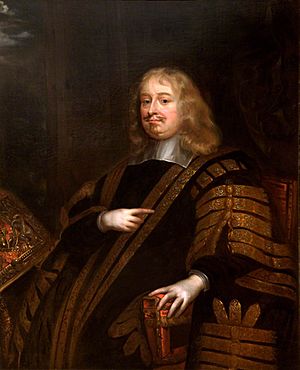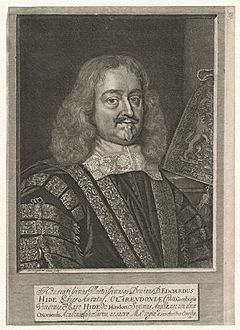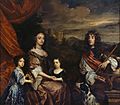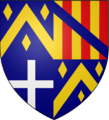Edward Hyde, 1st Earl of Clarendon facts for kids
Quick facts for kids
The Earl of Clarendon
|
|
|---|---|

Portrait by Peter Lely
|
|
| First Lord of the Treasury | |
| In office 19 June 1660 – 8 September 1660 |
|
| Monarch | Charles II of England |
| Preceded by | The Lord Cottington (Lord High Treasurer) |
| Succeeded by | Thomas Wriothesley, 4th Earl of Southampton |
| Lord Chancellor | |
| In office 1660–1667 |
|
| Preceded by | Vacant (last held by Sir Edward Herbert) |
| Succeeded by | Orlando Bridgeman |
| Chancellor, University of Oxford | |
| In office 1660–1667 |
|
| Member of the Long Parliament for Saltash |
|
| In office November 1640 – August 1642 (disbarred) |
|
| Member of the Short Parliament for Wootton Bassett |
|
| In office April 1640 – May 1640 |
|
| Personal details | |
| Born | 18 February 1609 Dinton, Wiltshire, England |
| Died | 9 December 1674 (aged 65) Rouen, France |
| Resting place | Westminster Abbey |
| Spouses |
Anne Ayliffe
(m. 1629; died 1629) |
| Relations | Mary II of England (granddaughter) Anne, Queen of Great Britain (granddaughter) |
| Children | Henry Hyde, 2nd Earl of Clarendon Laurence Hyde, 1st Earl of Rochester Edward Hyde James Hyde Anne, Duchess of York Frances Hyde |
| Parents | Henry Hyde Mary Langford |
| Alma mater | Hertford College, Oxford |
| Occupation |
|
| Signature | |
Edward Hyde, 1st Earl of Clarendon (born 18 February 1609 – died 9 December 1674) was an important English statesman, lawyer, and historian. He was a chief advisor to King Charles I during the First English Civil War. Later, he became Lord Chancellor to King Charles II from 1660 to 1667.
Hyde mostly stayed out of political arguments in the 1630s. But in November 1640, he was elected to the Long Parliament. He believed King Charles I had gone too far by trying to rule without Parliament. However, by 1642, he felt Parliament's leaders were trying to gain too much power for themselves.
Hyde strongly believed in the Church of England and its traditional structure. He opposed attempts by Puritan groups to change it. This belief guided many of his decisions over the next twenty years. He joined King Charles I in York just before the Civil War began in August 1642. He served as the King's main political advisor.
As the war went badly for the Royalists, Hyde's influence decreased. He refused to make alliances with Scottish Covenanters or Irish Catholics.
In 1644, the King's son, who would become Charles II, was put in charge of the West Country. Hyde was part of his Governing Council. When the Royalists lost the war in June 1646, Hyde went into exile with the younger Charles. After Charles I was executed in January 1649, Charles II was seen as the rightful king by Royalists.
Hyde did not take part in the Second English Civil War or Third English Civil War. These wars involved alliances with Scottish and English Presbyterians, which Hyde opposed. Instead, he worked as a diplomat in Paris and Madrid.
After the monarchy was restored in 1660, Charles II made Hyde Chancellor of the Exchequer. Hyde's daughter, Anne, married the future James II. This made Hyde the grandfather of two future queens, Mary II and Anne.
These family connections brought him both power and enemies. King Charles II also became annoyed by Hyde's frequent criticisms. Even though Hyde had limited responsibility for the difficult Second Anglo-Dutch War (1665-1667), he was accused of serious wrongdoing. He was forced to leave England and live in exile permanently. He lived in Europe until he died in 1674. During this time, he finished his famous book, The History of the Rebellion. This book is now considered one of the most important histories of the 1642-1646 Civil War.
Contents
Early Life and Family
Edward Hyde was born on 18 February 1609, in Dinton, Wiltshire, England. He was the sixth of nine children. His parents were Henry Hyde and Mary Langford.
His father and two of his uncles were lawyers. Edward first studied at Gillingham School. In 1622, he went to Hertford College, Oxford, and graduated in 1626. He was originally meant to become a priest in the Church of England. However, his older brothers died, making him his father's heir. So, he decided to study law instead.
Edward Hyde married twice. His first wife was Anne Ayliffe in 1629, but she died six months later. In 1634, he married Frances Aylesbury. They had six children who grew up: Henry, Laurence, Edward, James, Anne, and Frances. His daughter Anne is the most famous because she became the mother of two queens, Mary II and Anne.
Early Career and Friendships
Hyde later said he wasn't very interested in a legal career. He felt he learned most from his friendships with important people of his time. These friends included famous writers like Ben Jonson and John Selden. His closest friend was Lord Falkland.
Hyde was a key member of the "Great Tew Circle." This was a group of thinkers who met at Lord Falkland's home in Oxfordshire. They enjoyed discussing ideas and learning from each other.
In 1633, Hyde became a lawyer. He quickly became successful. In 1634, he was given a job managing legal documents for the Court of Common Pleas. He also earned the respect of Archbishop William Laud. Hyde admired Laud for his honesty and good character.
Role in the English Civil War

In April 1640, Hyde was elected to Parliament. He first criticized King Charles I. However, he became more supportive of the King as Charles began to accept some reforms from Parliament. Hyde did not like laws that limited the King's power to choose his own advisors. He saw this as disrespectful to the King's authority.
He slowly moved to the Royalist side. He strongly supported the Church of England. He also opposed the execution of the Earl of Strafford, who was a main advisor to Charles. After a document called the Grand Remonstrance in 1641, Hyde became an unofficial advisor to the King. He left London in May 1642 and joined the King in York.
In February 1643, Hyde was made a knight. He was also officially appointed to the Privy Council, a group of royal advisors. The next month, he became Chancellor of the Exchequer, a top financial role.
Hyde found it hard to forgive anyone who fought for Parliament, even friends. He ended many personal friendships because of this. He was deeply saddened by the death of his best friend, Lord Falkland, in September 1643. Hyde called it "a loss most infamous and execrable."
In 1644, the Royalist-controlled West Country was given its own government. The Prince of Wales was in charge, and Hyde was on his General Council. This move was partly to keep Hyde away from the King. Hyde found it difficult to control some military commanders. One general, George Goring, Lord Goring, often refused to follow orders. His troops were known for looting and drinking.
After the Royalists lost the war, Hyde went to Jersey in 1646. He did not get involved in the 1648 Second English Civil War. This war led to the execution of Charles I in January 1649. Hyde was horrified by the King's execution. He later described Charles as a smart man who sometimes doubted his own good judgment.
After the Royalists lost the Third English Civil War in 1651, Hyde continued to advise Charles II. He was appointed Lord Chancellor in 1658. He also used his sister, Susanna, as a Royalist agent. She was arrested in 1656 and died in prison soon after.
Return to Power and Downfall
After the monarchy was restored in 1660, Hyde returned to England. He became even closer to the royal family when his daughter Anne married the King's brother, James, Duke of York. Many people thought Hyde had planned this royal marriage. However, historians generally agree that he did not. He was reportedly shocked by it.
Hyde was made a Baron in November 1660. The next year, he was given the titles of Viscount Cornbury and Earl of Clarendon. He also served as Chancellor of the University of Oxford from 1660 to 1667.
As a leading minister, he worked to keep the promises made in the Declaration of Breda. This document helped bring Charles II back to the throne. He worked hard to offer mercy to most of the King's former enemies. This was largely achieved through the Act of Indemnity and Oblivion.
Hyde played a key role in arranging Charles II's marriage to Catherine of Braganza. This later caused problems for him. Clarendon liked the Queen but disapproved of the King openly having mistresses. The King did not like anyone interfering with his private life. The Queen's inability to have children also hurt Clarendon. This was because his own grandchildren were now closer to the throne.
The "Clarendon Code" was a series of laws designed to keep the Church of England supreme. It is named after Clarendon, but he was not heavily involved in writing it. In fact, he disagreed with much of its content. The "Great Tew Circle," which he was part of, believed in tolerance for different religious views.
In 1663, Hyde was one of eight Lords Proprietor given control of a large area of land in North America. This land became the Province of Carolina. Soon after, he was accused of wrongdoing by George Digby, 2nd Earl of Bristol, a political opponent. He was blamed for arranging Charles's marriage to a woman he knew could not have children. This was supposedly to secure the throne for his daughter Anne's children. His grand new home, Clarendon House, was also seen as proof of corruption. He was also blamed for the Sale of Dunkirk and the cost of supporting the colony of Tangiers. These were acquired as part of Catherine's dowry. People even broke the windows of Clarendon House and put up signs blaming him.
These accusations were not taken seriously at first. However, Hyde became more and more unpopular with the public and with King Charles. He often lectured Charles about his faults. His disapproval of Charles's mistress earned him her hatred. She worked with others to bring him down.
Hyde's power weakened due to his poor health. He suffered from severe gout and back pain. These issues often left him unable to work for months. Even neutral observers saw him as a problem. When he refused to retire, some people spread false rumors that he wanted to step down.
The military losses in the Second Anglo-Dutch War (1665-1667) were the main cause of his downfall. The disasters of the Plague of 1665 and the Great Fire of London also contributed. The successful Dutch raid on the Medway in June 1667 was the final blow. Even though he had opposed the war, he was removed from office.
Around the same time, his wife died after a short illness. Clarendon was accused of serious crimes by the House of Commons. He was forced to flee to France in November 1667. The King made it clear he would not defend him. This betrayal harmed Charles's reputation. An Act was passed in December that forced Hyde into banishment. Few people spoke in his defense.
Exile, Death, and Legacy
Clarendon spent the rest of his life in exile. He traveled through France, suffering from gout and poor health. For a time, he was not allowed to see any of his children. Writing to him was even considered treason. However, his sons did visit him in his later years.
During his exile, he updated and expanded his book, The History of the Rebellion. This book is a classic account of the Wars of the Three Kingdoms. It is what he is best remembered for today. The money from selling this book helped build the Clarendon Building and the Clarendon Fund at Oxford University Press.
The famous diarist Samuel Pepys wrote that he never knew anyone who could speak as well as Hyde.
Edward Hyde died in Rouen, France, on 9 December 1674. His body was brought back to England. He was buried in a private ceremony at Westminster Abbey on 4 January 1675.
Images for kids
See also
 In Spanish: Edward Hyde para niños
In Spanish: Edward Hyde para niños











